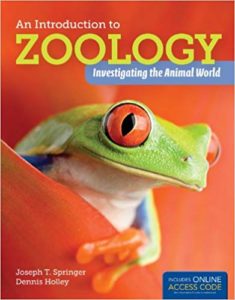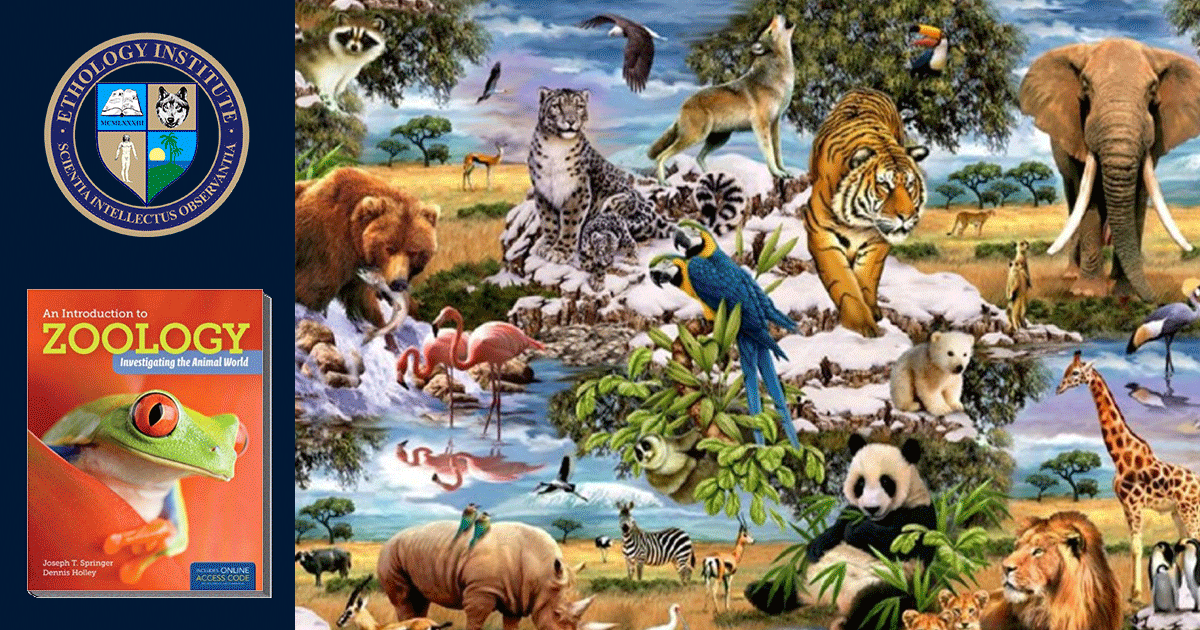Course Description
Zoology is the branch of biology that studies the structure, embryology, evolution, classification, habits, and distribution of all animals, both living and extinct. This course is only an introduction to this vast subject-matter. Its goal is to give you a better understanding of the various species. It was Charles Darwin in his ‘The Origin Of Species By Means Of Natural Selection’ (1859) who first formulated the hypothesis that species evolved as a result of the struggle for life, i.e. as a result of natural selection, where the fittest had an advantage.
Both lessons consist of movies. The first one gives you a good review of how you classify animals. The second one reviews mammals. The textbook, “An Introduction to Zoology: Investigating the Animal World” provides you with an accessible and engaging look at the fundamentals of zoology. Sections at the end of each chapter discuss how the animals described in the chapter connect to us from an economic, ecologic, medical, and cultural perspective, emphasizing how the animal world and the human realm are intimately intertwined.
End-of-chapter questions challenge your ability to think critically, and they support the development of your science process skills (e.g., communication, formulating hypotheses, experimental design).
It’s a big book with material for many hours of study. You do not need to read it from one end to the other to pass the course quiz. Since this course belongs to the CAAE program with courses at the undergraduate and graduate level, we leave it up to you to plan your studies. Join the course forum and keep in touch with your tutors and peers.
Course Level
Intermediate/Advanced. This course is an introduction to zoology at the undergraduate level.
Course Textbook
“An Introduction to Zoology: Investigating the Animal World”
by Joseph T. Springer and Dennis Holley.
Book contents
Chapter 1 Zoology: Investigating the Animal World
Chapter 2 Ecology of Animals: Populations and Communities
Chapter 3 Ecology of Animals: Ecosystems and Biomes
Chapter 4 The Animal Body: Matters of Form and Behavior
Chapter 5 Phylogeny and Taxonomy: Questions of Origins and Organization
Chapter 6 Phylum Porifera: Exploring Sponges
Chapter 7 Phylum Cnidaria and Phylum Ctenophora: A Radial Existence
Chapter 8 Phylum Platyhelminthes and Phylum Nemertea: The Acoelomate Body Plan
Chapter 9 Pseudocoelomates: The Rise of Hollowness
Chapter 10 Phylum Annelida: Masters of Coeloms and Segments
Chapter 11 Phylum Mollusca: A Scheme of Shells and Tentacles
Chapter 12 Phylum Arthropoda: Sovereigns of the Terran Empire
Chapter 13 Phylum Echinodermata: Bizarre Benthic Beings
Chapter 14 Phylum Hemichordata and Phylum Chordata: The Backbone Arises
Chapter 15 Fishes: Monarchs of an Ancient Realm
Chapter 16 Amphibians: Between Two Worlds
Chapter 17 Reptiles: Shattered Remains
Chapter 18 Birds: Lords of the Air
Chapter 19 Mammals: The Magnificent Hairy Ones
Chapter 20 The Human Condition: Rise of the Cultural Ape
Appendix A Scientific Writing
Appendix B Charting the Patterns of Evolution
Glossary
- Springer, J.T. and Holley, D. (2012). An Introduction to Zoology: Investigating the Animal World. Jones & Bartlett Learning; Har/Psc edition (January 27, 2012).

Supplementary Literature
Although not mandatory, we recommend that you supplement your readings with:
- Darwin, C. (1859) On the origin of species by means of natural selection, or the preservation of favoured races in the struggle for life. London: John Murray. 1st ed.
- Dawkins, R. (2006) The Selfish Gene. Oxford University Press, USA.
- McFarland, D. (1982) The Oxford Companion to Animal Behaviour. Oxford University Press, Oxford.
- McFarland, D. (1998) Animal Behaviour. Benjamin Cummings. 3rd ed.
Online Studying and Tutoring
Watch the movie(s) and read the book(s). Join the course forum where you can read our tutors’ answers to questions previously posed by your colleagues. If you have a new question, do not hesitate in posting it.
The course forum is solely for academic questions. For administrative matters or difficulties accessing the functionality of the site, please submit a ticket.
Once you’re ready for it, take the quizzes. You may take a quiz as many times as you like. We recommend you re-take quizzes once a year as a self-imposed quality control.
Course Materials
The textbook, “An Introduction to Zoology: Investigating the Animal World” by Joseph T. Springer and Dennis Holley is not included in the course.

